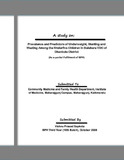Please use this identifier to cite or link to this item:
https://hdl.handle.net/20.500.14356/337Full metadata record
| DC Field | Value | Language |
|---|---|---|
| dc.contributor.author | Sapkota, Vishnu Prasad | |
| dc.date.accessioned | 2012-12-31T23:13:14Z | |
| dc.date.accessioned | 2022-11-08T10:14:24Z | - |
| dc.date.available | 2012-12-31T23:13:14Z | |
| dc.date.available | 2022-11-08T10:14:24Z | - |
| dc.date.issued | 2008 | |
| dc.identifier.uri | http://103.69.126.140:8080/handle/20.500.14356/337 | - |
| dc.description.abstract | Summary: This cross-sectional comparative study was carried out in Belahara VDC of Dhankuta district to assess the prevalence and predictors of the underweight, stunting and wasting. The Study includes 150 children sampled from the VDC with allowable error of 20 percent. Information regarding exposure to different predictors were obtained from their mothers while anthropometric measurements were directly taken from under five children. Binary Logistic Regression statistical tool was used to determine the influence of different predictors on child‟s being undernourished. Regarding the socio-demographic characteristics, half of the study children were infants and almost three fourth were of disadvantaged castes as per the HMIS classification. Socioeconomic status, a composite indicator based on cultivatable land, food sufficiency and housing type, found that almost 50 percent of the children were of poor socioeconomic status. Half of the under five children were living in nuclear family and almost 40 percent were reared in the family with two children. Half of the children were reared form mothers who have academic qualification of primary level and one third born while their mothers were in teen age. Almost 23 percent of under five children were found to suffer from ARI in the period of one month before data collection. Almost one third under five children got birth from the mothers who smoked or took alcohol during pregnancy. Regarding the nutritional status, one third of under five children were stunted and almost one in ten were severely stunted. One fourth were found underweight. Wasting was almost equal to national average. Under nutrition was found less than national average but wasn‟t good if weighted against developmental indicators of Dhankuta district. As the age of child increased, their chance of being underweight and stunted also increased. Analyzing different predictors using Binary Logistic Regression found that being male was protective factor for stunting i.e. chronic under nutrition. Living in the joint family was protective factor for both stunted and underweight. This might be due to the fact that in agrarian society, mothers, who are main care taker of children, are engaged in field whole day, so if grandparents are there, children are reared well. Further, socioeconomic status was found to have strong influence on child‟s being underweight and stunted as children living in the poor family were most likely to be undernourished. Further, medium socioeconomic status was also a significant risk factor for stunting as in this study medium socioeconomic status includes those families who have either lowest cultivatable land or lowest food sufficiency duration; this obliviously affects the nutritional status in long run. A child born to mother, when her age was more than 35, was a strong risk factor for both stunting and underweight. This might be due to the fact that, being disadvantaged community, there was high prevalence of smoking and drinking habits among the mothers, which gradually depletes the nutritional stores of the mother and as the age increases and due to the high work load, depletion reaches to highest degree and ultimately pregnancy during this stage i.e. more than 35 years, becomes the risk factor of underweight and stunting. Due to the less number of wasting cases, logistic regression wasn‟t applicable. So χ2 test was used for predictor analysis. This showed that wasting was significantly high among the females than in male children. Other variables that are risk factors for the wasting in national and international literature, weren‟t found significant in this study because of the inadequate sample size. Based on the study findings, the study recommends the measures at the district level. The Health Management Information System should use the survey results to monitor and evaluate the progress in the nutritional programme. Being the acute under nutrition more than 10 percent, study recommends immediate interventions to be implemented for addressing the high acute under nutrition by District Public Health Authority. Integrated Management of Childhood Illness should also effectively monitor the nutritional status of children as under nutrition was found likely during illness. Nutritional education programme as such should be strengthened in the district. | en_US |
| dc.language.iso | en_US | en_US |
| dc.publisher | Community Medicine and Family Health Department, Institute of Medicine, Maharajgunj Campus, Maharajgunj, Kathmandu | en_US |
| dc.title | Prevalence and Predictors of Underweight, Stunting and Wasting Among the Under five Children in Belahara VDC of Dhankuta District | en_US |
| dc.type | Technical Report | en_US |
| Appears in Collections: | Post Graduate Grant (PG) Reports | |
Items in DSpace are protected by copyright, with all rights reserved, unless otherwise indicated.

